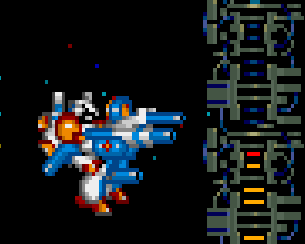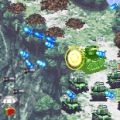Side Arms sits in the middle of Capcom’s loose “Flying Guy” trilogy. While not particularly obscure, it’s generally not as well known as its related games, Section Z and Forgotten Worlds, because its only contemporary console port was to the TurboGrafx-16.
Side Arms was the debut work of artist Akira “Akiman” Yasuda, who became world renowned for his later work on the Street Fighter series. It also shameless wears its Gundam inspiration on its head. One of the regular enemies you’ll fight are basically just the Zaku robots, famous for its red Cyclops-like eye.
When Side Arms was re-released as part of the Capcom Arcade 2nd Stadium, some legal team probably felt that this felt too close to the sun, so these sprites were changed slightly to remove the shoulder pads and get rid of that red eye. That being said, the similarity is still pretty clear.
What’s more amusing is what Capcom felt they could get away with. One of the weapons in Side Arms is the M.B.L, or Mega Bazooka Launcher. This isn’t even hiding the fact that this weapon was taken directly from Zeta Gundam, being one of the weapons used by Char’s Hyaku Shiki.
This was kept unaltered in Capcom Arcade 2nd Stadium, probably because the design is distinct enough that it can’t be considered a straight copy. The Japanese in-game instruction manual actually makes a reference to one of Char’s lines, “eei, mamayo…!” (“Whatever happens, happens…” or “here goes nothing”), making its origins explicit. This was removed from the English manual because the reference would likely go over the head of most English speakers, since Zeta Gundam isn’t nearly as well-known among the international audience as it is in Japan.
“Hit the boss with the M.B.L. It’s recommended to use the MBL, which boasts overwhelming firepower, to challenge the boss of each stage. It’s effective against bosses because of its high power and its ability to penetrate enemies. Even if you’re not sure where to aim, if you use it with the spirit of “here goes nothing!”, you should be able to hit it.
This isn’t the only anime reference in Side Arms. These distinct floating heads in stage 4 look like Japanese clay figures, but they’re likely meant as references to the Bandok fortress from Invincible Super Man Zambot 3, an early super robot show directed by Gundam creator Yoshiyuki Tomino.
On the ground of Stage 4, you can also find the remnants of the God Warrior from Nausicaa of the Valley of the Wind.
You could probably do a whole other write-up about references to Nausicaa, as its famed giant Ohmu insect has also appeared in many video games over the years.
Space Harrier also had a robot enemy called Dom, again based on a mecha from Gundam. The PlayStation 2 remake changed the design to something less infringing and renamed, but later releases kept the original design, because it’s just different enough that it’s not technically a copy.
As for Akiman, after leaving Capcom, he later went on to work on the Gundam franchise in an official capacity, doing some character design’s for the 1999 anime Turn A Gundam. Capcom themselves also began developing some Gundam tie-ins, beginning with 2001’s Mobile Suit Gundam: Federation vs. Zeon. In that way, Side Arms can be seen as the start of the relationship between Capcom and Gundam.
Links:


